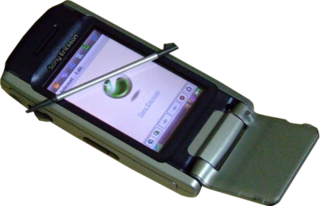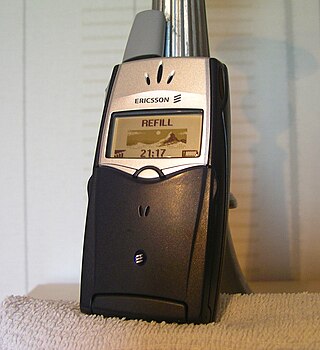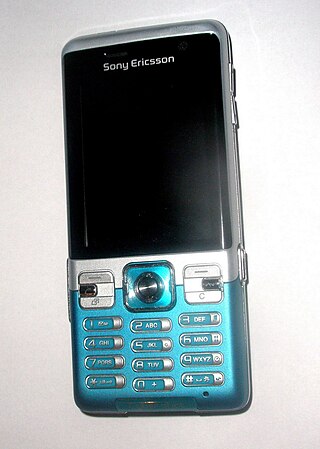
The Ericsson T28s is a GSM dual-band, compact flip mobile phone manufactured by Swedish telecoms company Ericsson Mobile Communications in 1999.

The Ericsson T28s is a GSM dual-band, compact flip mobile phone manufactured by Swedish telecoms company Ericsson Mobile Communications in 1999.
The T28 was the lightest and slimmest mobile phone at the time, with a weight of only 83 grams. [1]
Like many mobile phones of the time (1999) it had a fixed, stubby external antenna. It was probably best known as the first phone that used lithium polymer batteries. At one point, it was the best selling mobile phone in America.
In terms of market positioning, Ericsson designated this as a premium phone, as such it was priced substantially higher (often more than triple) the price of the T10 and T18 devices - their nearest cosmetic and functional competitors. It has a tiny LCD screen and a spring-loaded latch mechanism to release the 'flip.'
Four different versions of the T28 were sold. T28z was compatible with GSM1900 for use in North America. T28s was compatible with GSM900/1800 for use in the rest of the world - this is by far the most common version. T28 World was compatible with GSM900/1900 for use worldwide on GSM900 and North America on GSM1900 (this was the second World phone Ericsson introduced, the first being the I888 which had the distinction of being the first commercially available GSM900/1900 phone). A special version, the T28sc was released in China with support for reading and entering Chinese characters.
The device came in three colours—very dark blue, lighter blue and sand. The sand version being the least common.
The device was listed as compatible with two batteries. A normal slim-line and an ultra-slim lower capacity battery. However the device was also battery-compatible with the later R320 and R520 series.

The Sony Ericsson P900 is a Symbian OS v7.0 based smartphone from Sony Ericsson.

The Sony Ericsson T610, released in 2003, is a mobile phone manufactured by Sony Ericsson. It was one of the first widely available mobile phones to include a built-in digital camera, Bluetooth, color screen, joystick navigation, and was a very high selling model. The T630 was a later variant.
GSM frequency bands or frequency ranges are the cellular frequencies designated by the ITU for the operation of GSM mobile phones and other mobile devices.

The Sony Ericsson K700 was introduced in 2004 as a high-end mobile phone, and as a successor to the T630. It was succeeded by the K750.

Siemens Mobile was a German mobile phone manufacturer and a division of Siemens AG. Siemens sold Siemens Mobile to the Taiwan-based BenQ in 2005, subsequently becoming BenQ-Siemens and succeeded by Gigaset. The last Siemens-branded mobile phones, the AL21, A31 and AF51, were released in November 2005.

The Sony Ericsson K750, introduced in June 2005, was a high-end mobile phone, the successor to the now discontinued K700, and which was succeeded by the K800i in Q2 2006.

Nokia 8210 is a mobile phone by Nokia, announced on 8 October 1999 in Paris. At the time, it was the smallest, lightest Nokia mobile phone on the market, thus its selling point was based on its design and customization, with removable Xpress-on covers. Six differently coloured Xpress-on covers are available, as well as many third-party ones.

The Motorola StarTAC, first released on January 3, 1996, is often assumed to be the first ever clamshell (flip) mobile phone. Technically, however, NEC had been releasing flip phones on NTT Docomo's PDC Mova network long before 1996, namely the TZ-804 and TZ-1501, both respectively launched in 1991 and late 1994. Another early precursor of this form factor was the Grillo, which was designed in Italy by Richard Sapper and Marco Zanuso in 1965. The StarTAC is the successor of the MicroTAC, a semi-clamshell design first launched in 1989. Whereas the MicroTAC's flip folded down from below the keypad, the StarTAC folded up from above the display. In 2005, PC World named the StarTAC as the 6th Greatest Gadget of the Past 50 Years. The StarTAC was among the first mobile phones to gain widespread consumer adoption; approximately 60 million StarTACs were sold.

The Sony Ericsson K800i, and its variant, the Sony Ericsson K790, are mobile phone handsets manufactured by Sony Ericsson. Launched in July 2006, the phones are the successor to the Sony Ericsson K750i. Both of the phones feature a 3.2-megapixel digital camera complete with a xenon flash, a protective lens cover, and a new "BestPic" bracketing feature, and are the first to be tagged with the Sony Cyber-shot branding. The new "BestPic" feature takes 9 full quality snapshots of a subject in quick succession, allowing the user to choose the best shots from them. On the entertainment front, the phones have a media player supporting MP3, AAC/AAC+/eAAC+ and WMA music files and 3GP/MPEG-4 video files. The phones also feature a RDS FM radio, and a Memory Stick Micro (M2) slot for expandable solid state memory. The K790/K800 models are also the first Sony Ericsson mobile phones to use ATI's Imageon 2192 graphics engine, which delivers a full 3D gaming graphics for Java and full support for its 3.2-megapixel camera. It is the phone used by James Bond in the 2006 Casino Royale film and trailers.
The Nokia 8850 is a mobile phone handset manufactured by Nokia. It was a light alloy-bodied enhanced version of Nokia 8210 model with slider protection of the keypad and white lighting of the keypad and screen. The 8850 is considered to be an un-repairable phone, thus resulting in very few active handsets in the market. Today it remains a collector's item. It also came in gold. It was introduced as a successor of an earlier model, the chrome phone Nokia 8810.

The Motorola MicroTAC is a cellular phone first manufactured as an analog version in 1989. GSM-compatible and TDMA/Dual-Mode versions were introduced in 1994. The MicroTAC introduced a new "flip" design, where the "mouthpiece" folded over the keypad, although on later production the "mouthpiece" was actually located in the base of the phone, along with the ringer. This set the standard and became the model for modern flip phones today. Its predecessor was the much larger Motorola DynaTAC and it was succeeded by the Motorola StarTAC in 1996. "TAC" was an abbreviation of "Total Area Coverage" in all three models.

The Sony Ericsson K850i is a high-end mobile phone when released in October 2007. It was announced in June 2007 as the flagship product in Sony Ericsson's K ("Kamera") series, with a 5 megapixel CMOS camera sensor. The K850 was the first Sony Ericsson phone released outside of NTT DoCoMo to support microSD and microSDHC along with Sony's traditional M2. It also introduces the usage of three touch-sensitive softkeys right under the display and a new form of navigation button, omitting the classic joystick introduced with the Ericsson T68. The camera interface has been revamped to resemble the format of cybershot digital cameras. According to the manufacturer the UMTS talk time has been significantly increased to 3 hours 30 min over its predecessor, the K800 and K810.. It was Sony Ericsson's first 3.5G HSDPA supporting mobile phone, and was also the first 3G "global" mobile with supporting all major operating network frequency in the world including GSM 850, GSM 900, GSM 1800, GSM 1900, HSDPA, UMTS 850, UMTS 1900, UMTS 2100.

The Ericsson R290 is a combined GSM and satellite phone using the Globalstar satellite network. The R290 was introduced in June 1999 and manufactured in the United Kingdom by Ericsson Mobile Communications.

Ericsson T39 was a GSM mobile phone released by Ericsson Mobile Communications in 2001, it was the follow-up to the T28 and T29.

The Ericsson R380 is a GSM smartphone developed by Ericsson Mobile Communications. It combines the functions of a mobile phone and a personal digital assistant (PDA), and was introduced at CEBIT on 18 March 1999.

Sony Ericsson C702 is a mobile phone handset manufactured by Sony Ericsson. The phone features a 3.2-megapixel digital camera with LED flash and a few features such as geo-tagging and face detection. On the entertainment front, the phone has a media player supporting MP3, AAC/AAC+/eAAC+ and WMA music files and 3GP/MPEG-4 video files. The phone also features a RDS FM radio, and a Memory Stick Micro (M2) slot for expandable solid state memory

The Sony Ericsson Xperia X10 is a 2010 high end smartphone in the Xperia series designed by Sony Ericsson. It was the first Sony Ericsson smartphone to run the Android operating system. The phone was shipped with Android 1.6 (Donut), but an upgrade to 2.1 (Eclair) was made available starting 31 October 2010, with a gradual international rollout. Originally, Sony Ericsson stated that the X10 would not receive an upgrade to Android 2.2 (Froyo) or beyond, but the phone was later upgraded to 2.3.3 (Gingerbread) with the updates starting on 29 July 2011.

The Samsung SGH-U900 is a slider mobile phone from Samsung Telecommunications. It was introduced at Mobile World Congress on 11 February 2008. It is a member of Samsung's fashion-focused "Ultra" line of handsets and the company's flagship at the time.